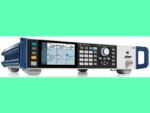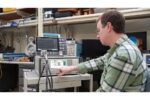The SMB100B series from Rohde & Schwarz produces microwave carriers to 40 GHz. Test-instrument manufacturer Rohde & Schwarz introduced a series of four microwave signal generators, the SMB100B. The instruments come with four models depending on top frequency: 12.75 GHz, 20 GHz, 31.8 GHz, and 40 GHz. All models support AM, FM, phase, and pulse […]
Test and Measurement Tips
What is intermodulation, and is it good or bad? Part 2
A mixer can upconvert and downconvert a modulated signal with no loss of baseband information. Part 1 of this series described intermodulation resulting from the combining of two or more sinusoidal signals through a nonlinear device such as the mixer in Figure 1. The mixer’s output is the product of its two inputs, and its […]
What is intermodulation, and is it good or bad? Part 1
Sinusoidal inputs applied to a nonlinear system produce an output containing different frequencies, and the results can be good, bad, or ugly. According to the dictionary definition, intermodulation is “the production in an electrical device of currents having frequencies equal to the sums and differences of frequencies supplied to the device.” In the literature of […]
Calibrator automates oscilloscope calibrations on four channels
Fluke’s 9500C oscilloscope calibrator with remote heads streamlines oscilloscope calibration from the front panel and through PC software.
Measure RF power from 25 MHz to 1 GHz with your laptop
Anritsu Company announces the launch of their new inline power sensor MA24103A which is designed to measure accurate Peak and True-RMS average power measurements from 25 MHz to 1 GHz and 2 mW to 150 W power range. Several applications demand accurate peak and average power measurements well below the frequency range of 1 GHz. […]
Solderless RF connectors attach to board edges for test applications
Samtec has released a new line of RF edge launch connectors with a narrow body design that is 33% smaller than traditional edge launch connectors. These connectors are commonly used in a lab setting for high-frequency test and measurement applications, high-speed digital component tests, and evaluation boards. Frequency capabilities are DC to 67 GHz (185-EL Series), […]
PCIe waveform generator card produces up to 20 sine waves
Spectrum Instrumentation has released a new firmware option for its range of versatile 16-bit Arbitrary Waveform Generators (AWGs) with sampling rates up to 1.25 GS/s and bandwidths up to 400 MHz. The new option costs $1200 and allows users to define 23 DDS cores per AWG-card, that can be routed to the hardware output channels. […]
APEC 2024: Test equipment
Test equipment is everywhere. Every trade show has it regardless of the focus. Power is no exception. At APEC 2024, EE World visited several booths displaying test equipment: meters, oscilloscopes, source-measure units (SMUs), bench power supplies, and electronic loads. The photos and videos below highlight what we saw, presented in alphabetical order by company. In […]
Function, arb generators and multimeters enhance test equipment lines
RIGOL Technologies is expanding its family of ultra-portable instruments with the introduction of the DG800 Pro and DG900 Pro Series Function / Arbitrary Waveform Generators, along with the DM858 Series Digital Multimeters. Like their predecessors—the DHO800 and DHO900 Series High-Resolution Oscilloscopes—these new generators and multimeters deliver impressive performance and functionality in a compact and light […]
Perform phase noise and VCO measurements to 50 GHz
Rohde & Schwarz bumps up the frequency with the FSPN50 phase noise analyzer and VCO tester.











